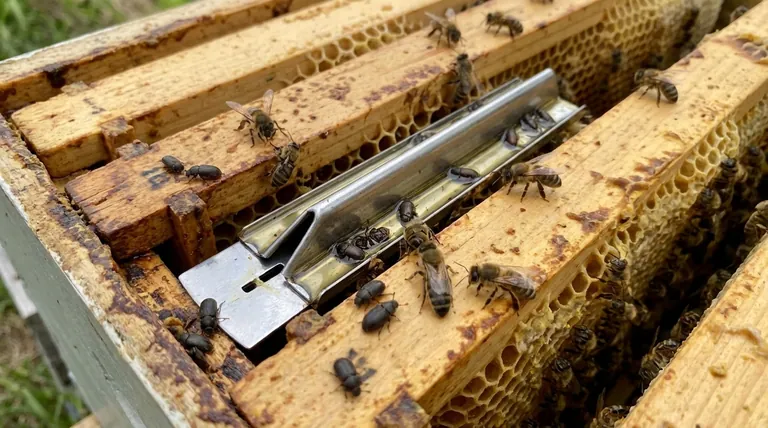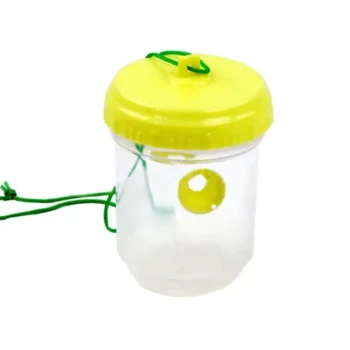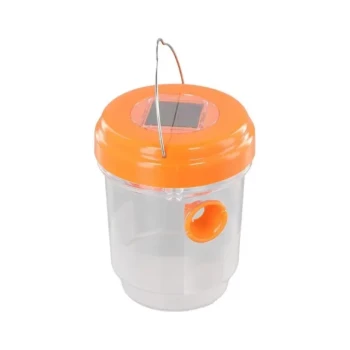In short, Beetle Blasters support bee colonies by trapping and killing adult small hive beetles. These simple devices are filled with oil, and as bees chase the invasive beetles, they fall into the traps and drown. This directly reduces the beetle population, preventing them from reproducing and overwhelming the hive, which in turn lowers the overall stress on the colony.
The core principle is simple: Beetle Blaster traps are a form of mechanical pest control that interrupts the small hive beetle's lifecycle. By removing adult beetles, you prevent them from laying eggs, which protects the hive from the far more destructive larval stage.

The Threat of the Small Hive Beetle
To understand why these traps are so effective, you first have to understand the problem they solve. The small hive beetle (Aethina tumida) is a scavenger and parasite of honey bee colonies.
How Beetles Damage a Hive
An unchecked beetle population can quickly overwhelm a colony. The primary damage is not from the adult beetles, but from their larvae.
Adult beetles lay eggs within the hive, and these eggs hatch into larvae that tunnel through comb. They consume honey, pollen, and even bee brood.
The Problem with Fermentation
As beetle larvae feed, they defecate in the honey. This introduces a yeast that causes the honey to ferment and spoil, creating a slimy mess that is unusable by both bees and beekeepers. A severe infestation can ruin all the honey in a hive.
The Stress on the Colony
Honey bees are hygienic and will try to manage the beetles themselves. They expend significant energy and resources attempting to chase and imprison adult beetles in "jails" made of propolis.
This constant effort diverts worker bees from other critical tasks like foraging, caring for the queen, and raising young bees, weakening the entire colony.
How Beetle Traps Provide Support
Beetle Blaster traps are an integrated pest management tool designed to aid the bees' natural defensive behaviors.
A Simple Mechanical Design
The trap itself is a small, disposable plastic device with compartments. It is designed to hang between the frames inside a bee hive.
These compartments are filled with a small amount of mineral oil or vegetable oil. The trap is placed in an area where beetles are likely to hide from the bees.
Leveraging Bee Behavior
The traps work in partnership with the bees. As worker bees identify and chase adult hive beetles, they drive them to seek refuge. The beetles run into the trap's openings to escape the bees, where they fall into the oil and are killed.
Interrupting the Lifecycle
The most crucial function of the trap is breaking the reproductive cycle. Every adult beetle captured is one less beetle laying eggs. This prevents the population from exploding and protects the hive from the destructive larval stage.
Understanding the Trade-offs
While highly effective, beetle traps are a management tool, not a complete solution. Their effectiveness depends on proper use and an understanding of their limitations.
A Tool for Control, Not Eradication
Beetle traps will help you manage and suppress the beetle population, but they will rarely eliminate every single beetle from a hive or an apiary. Their goal is to keep the pest numbers at a level the bees can easily handle.
Placement is Critical
For the traps to work, they must be placed where beetles are most likely to be found. This is typically between the outer frames in the top hive box, where bees often chase them.
Maintenance is Required
The traps are not a "set it and forget it" solution. They must be checked during regular hive inspections. Over time, they will fill with dead beetles and the oil may need to be replaced for the trap to remain effective.
Making the Right Choice for Your Goal
Integrating beetle traps is a straightforward way to support your colony's health. Your strategy depends on your hive's current condition.
- If your primary focus is proactive prevention: Place one or two traps in strong hives to catch scout beetles early and prevent a population from ever taking hold.
- If your primary focus is managing a known infestation: Deploy multiple traps immediately to reduce the adult beetle population and give your bees the upper hand.
- If your primary focus is supporting a weaker colony: Using traps is essential to reduce the defensive burden on a small or struggling colony, allowing them to focus their energy on growth and recovery.
Ultimately, using traps like the Beetle Blaster empowers your bees to do what they do best by removing a significant and destructive source of stress.
Summary Table:
| Aspect | Benefit of Beetle Blaster Traps |
|---|---|
| Pest Control | Mechanically traps and kills adult small hive beetles. |
| Lifecycle Disruption | Prevents beetles from laying eggs, stopping destructive larvae. |
| Hive Health | Reduces colony stress and prevents honey fermentation. |
| Ease of Use | Simple, oil-filled design that leverages natural bee behavior. |
Protect your apiary's productivity and health. A small hive beetle infestation can quickly ruin honey stores and weaken your colonies. HONESTBEE supplies commercial apiaries and beekeeping equipment distributors with effective pest management tools like beetle traps. Let us help you safeguard your investment. Contact our wholesale team today to discuss your needs and browse our full catalog of beekeeping supplies.
Visual Guide

Related Products
- Reusable Aluminium Beetle Trap for Small Hive Beetles Silver Bullet
- Plastic Beetle Blaster Trap Beekeeping Tools and Supplies
- Reusable Clear Small Hive Beetle Traps for Beehives Beetle Trapping Tools
- Black Plastic Beetle Barn Hive Beetle Trap for Beehives
- Removable Washable Hive Beetle Trap Attractants for Small Hive Beetles
People Also Ask
- What are the steps for installing hive beetle traps? A Guide to Effective Beetle Control
- How do Beetle Blasters trap adult beetles? A Simple, Non-Chemical Pest Control Solution
- How do beetle blasters work to protect bee colonies? Effective IPM for Healthy Hives
- What are the chemical-free options for trapping hive beetles? Control Pests Without Chemicals
- How do hive beetle traps work? A Beekeeper's Guide to Non-Chemical Control



















